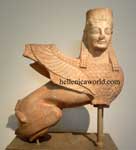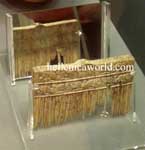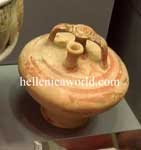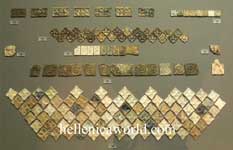.
Spata (Greek: Σπάτα, Arvanitika: Σ̈πάτα, Shpata[1]), is a town 20 kilometres (12 mi) east of Athens, Greece. Since the 2011 local government reform it is part of the municipality Spata-Artemida, of which it is the seat and a municipal unit.[2]
It is built on a saddle-shaped hill in the heart of the Mesogaian plain. The view of mount Hymettus is to the west, Mount Penteli to the north, and smaller mountains and hills to the east and south. Athens International Airport (Eleftherios Venizelos) covers the eastern portion of Spata, sometimes referred to as Spata Airport. Spata is passed by a road linking west to Paiania and east to Artemida and the interchange for Attiki Odos (number 19) is located west. It is located south of Pallini, south west of Rafina, west of Artemida, about 11 kilometres (6.8 mi) north west of Athens International Airport, and about 22 kilometres (14 mi) east south east of Athens.
The area around Spata is made up of residential, urban areas. Farmland, mostly vineyards and olive groves, lie around. Suburban housing arrived in the 1980s and the 1990s. In 1995, the eastern portion was committed to construction of the new Athens International Airport, which was completed in March 2001. The Attica Zoological Park, or Attica Zoo, began construction and was opened in May 2001 and is Athens' and Greece's largest zoo.
Spata has four kindergartens, three primary schools, two secondary schools, a police station with a small temporary detention facility, and a junior football/soccer team, Aittitos (Invincible).
The municipal unit of Spáta also includes the other towns or villages of Agía Kyriakí (pop. 540), Neápoli (461), Ágios Ioánnis (241), Velanidiá (237), Christoúpolis (230), Foínikas (229), Ágios Serafeím (220), Étos Stéko (111), Ágios Nikólaos Boúra (103), and Ímeros Péfkos (93).

28 : Statue of a Sphinx. Pentelic marble. Found in Spata, Attica.

2044 : Ivory comb with two rows of sphinxes and a rosette in the middle

Sp13- Sp20 : Glass-paste plaques decorated
History
The area included the ancient Athenian demes of Erchia (Ερχιά), birthplace of the historian and general Xenophon, and Kytheros (Κύθηρος); a Mycenean cemetery has been excavated at the southern edge of town, the exhibits being hosted in the National Archaeological Museum of Athens.
Since the Medieval Ages Spata has been inhabited by Arvanites. The town (then village) was created by the Medieval Albanian clan of Shpata, around the 15th century after they migrated from Epirus. It was named after Gjin Bua Shpata, who was despot of Arta in 14th century, and later on, it was abbreviated to Shpata, in the Arvanitic language.[1]
Historical population
Year Town population Municipality population
1981 6,398 -
1991 6,725 7,796
2001 8,167 10,419
References
^ a b Jochalas, Titos P. (1971): Über die Einwanderung der Albaner in Griechenland: Eine zusammenfassene Betrachtung ["On the immigration of Albanians to Greece: A summary"]. München: Trofenik. p. 26
^ Kallikratis law Greece Ministry of Interior (Greek)
| Ancient Greece
Science, Technology , Medicine , Warfare, , Biographies , Life , Cities/Places/Maps , Arts , Literature , Philosophy ,Olympics, Mythology , History , Images Medieval Greece / Byzantine Empire Science, Technology, Arts, , Warfare , Literature, Biographies, Icons, History Modern Greece Cities, Islands, Regions, Fauna/Flora ,Biographies , History , Warfare, Science/Technology, Literature, Music , Arts , Film/Actors , Sport , Fashion --- |
Retrieved from "http://en.wikipedia.org/"
All text is available under the terms of the GNU Free Documentation License



